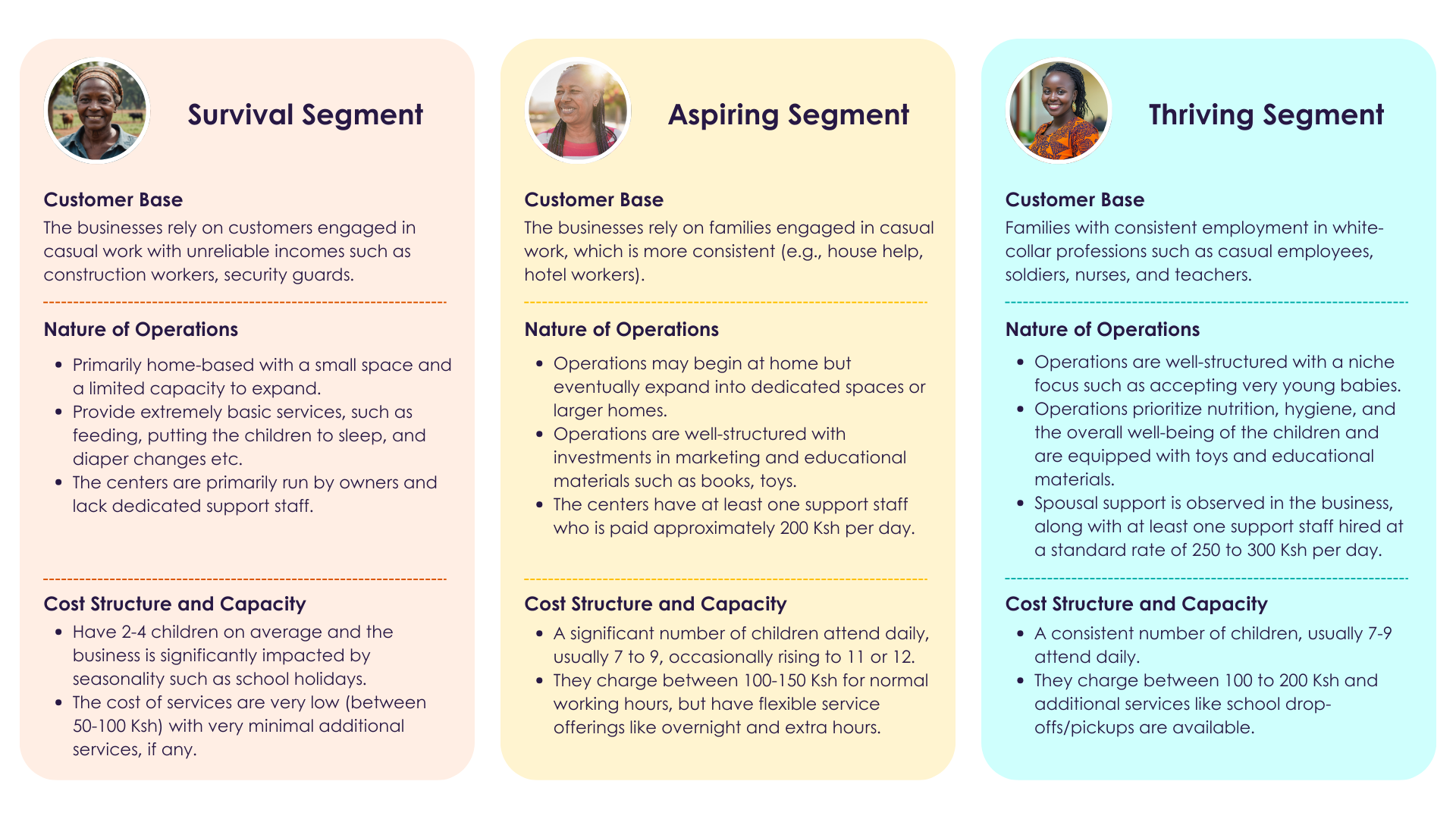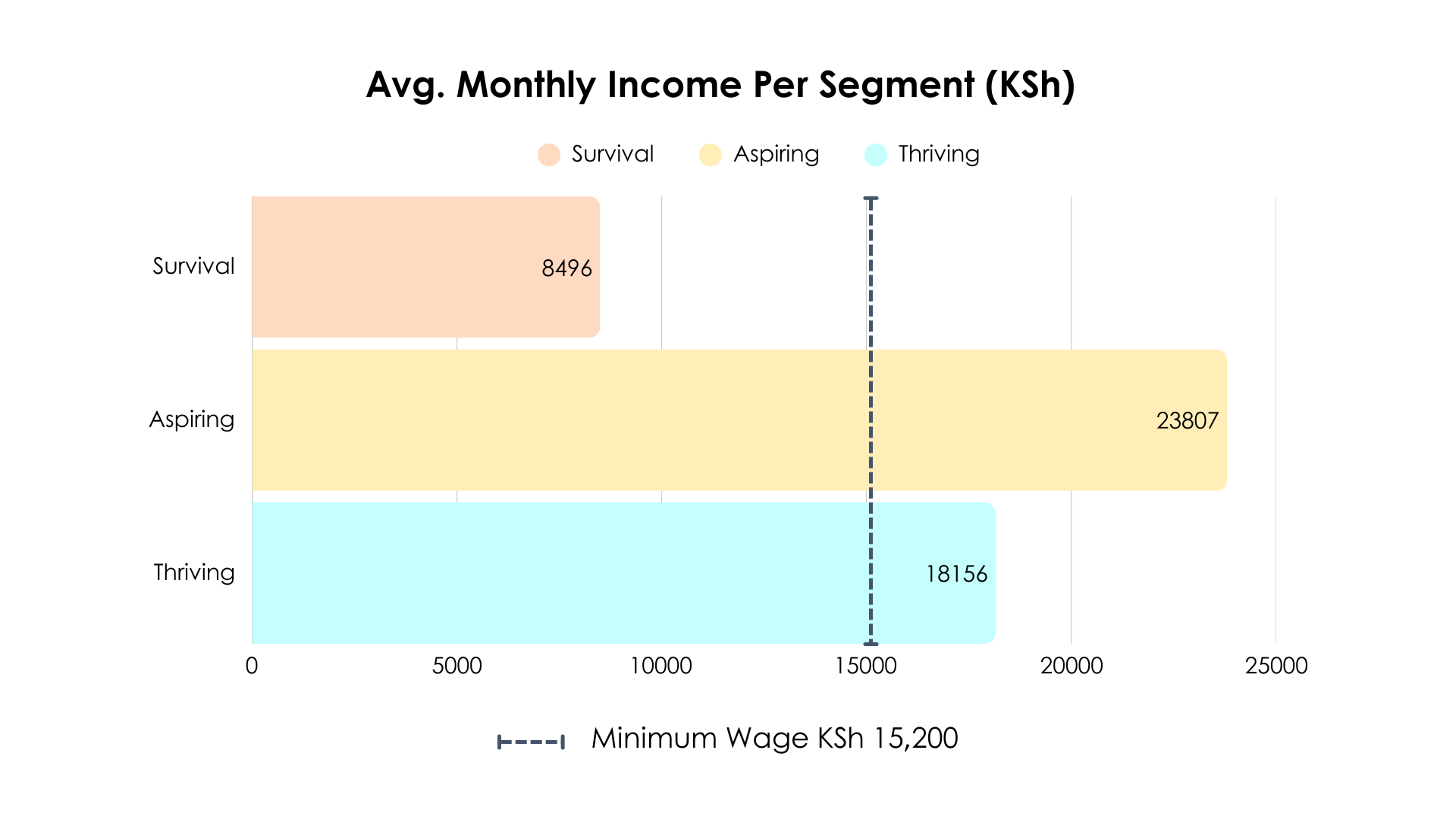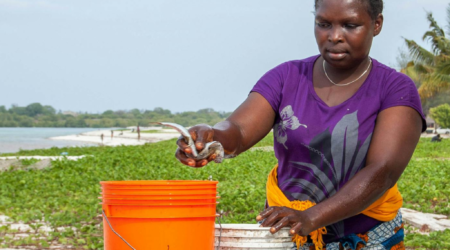The business of low-income childcare in Kenya

In Kenya’s rapidly urbanizing centers, childcare presents a critical challenge for working parents, particularly those in low-income communities. While demand for affordable childcare continues to grow, providers face significant barriers to creating sustainable businesses that offer quality care. This blog explores the childcare landscape in Kenya, highlighting both the challenges and potential pathways to success.
Early mornings at Milkah’s home are filled with the scent of fresh chapatis and the laughter of children. Milkah’s journey to financial independence began in 2020 with occasional babysitting that grew into a thriving daycare business through the Nawirika Foundation’s Totocare program. Starting with just three children, Milkah expanded to care for nine, offering additional services such as school drop-offs and overnight care. She now earns a net income of Ksh 15,900 per month (about $120), just slightly above Kenya’s minimum wage of Ksh 15,120, allowing her to support her family and reinvest in her business. However, her success is not typical in Kenya’s childcare sector, where many providers struggle to balance affordability, quality, and financial sustainability.
Nawirika Foundation’s social franchising program, Totocare, aims to address this by offering affordable care services and education programs in Kenya. The foundation offers training and mentorship to women running informal daycare centres, empowering them to start or expand their childcare micro-businesses. In areas where reliable childcare is scarce, this initiative is transformative – helping mothers stay employed, and ensuring children receive a strong foundation for their future. BFA Global partnered with the Nawirika Foundation under the Opportunity Leads Umbrella Fund project to evaluate the financial viability of operating low-cost childcare microbusinesses and to understand the factors that contribute to their commercial viability.
Challenges in the childcare sector
In Nairobi, 60% of the population lives in informal settlements, primarily made up of those migrating from rural areas with unstable, low-paying jobs. Informal daycare centers, often unregulated, fill the childcare gap for working parents but face significant hurdles.
Providers struggle with high operating costs, including rent, staff salaries, and utilities, and inconsistent payments from parents with fluctuating incomes. This results in cash flow issues and financial instability. Many operators lack the skills to manage finances effectively, leading to poor budgeting, inability to reinvest, and challenges in scaling up. Limited resources and the absence of formal training often lead to overcrowded facilities with inadequate hygiene, nutrition, and safety standards. Seasonal fluctuations also affect demand, causing unpredictable income patterns and financial strain during school holidays.
Marketing is another challenge. Many daycare providers rely on word-of-mouth referrals and lack strategies to promote their services effectively, leading to some having underutilized facilities. Additionally, businesses often depend on personal relationships rather than robust business practices, making payment collection difficult and income irregular. Despite these challenges, informal daycare centres continue to proliferate due to their affordability and accessibility.
Our research with the Nawirika Foundation revealed that these challenges do not affect all daycare providers equally. The extent to which these challenges impact businesses varies significantly among providers. Upon deeper assessment, we identified three distinct segments of daycare providers—Surviving, Aspiring, and Thriving—classified by service quality, business viability, nature of operations, and the drive to succeed. This segmentation helped us understand how these businesses operate, what enables some to succeed, and why others continue to struggle.
Understanding provider segments: Surviving, Aspiring, and Thriving

- Survival segment: These providers enter the business out of necessity, not passion. They generate low incomes (average Ksh 8,496 or $65 per month), offer basic services, and struggle with quality standards such as hygiene and nutrition. They have limited aspirations, with basic facilities, low enrollment and few additional services.
- Aspiring segment: Providers in this category have some experience in childcare and view the business as a path to financial independence. They consistently earn above minimum wage by attracting more children, and parents with informal but consistent jobs and offering additional services such as meal provisions and school pick-ups. While they earned more than the Thriving segment due to their high staff-to-child ratio (1:10), maintaining service quality is challenging.
- Thriving segment: These providers are entrepreneurial and have identified a key differentiator for their business. They achieve higher incomes by maintaining consistent enrollment and leveraging the value they provide to secure slightly higher and more consistent payments from parents with stable jobs, who can afford to pay for better-quality services at a slightly higher rate. They focus on early childhood development, maintaining a favorable staff-to-child ratio (1:5), and ensuring high standards in hygiene, safety, and nutrition.

Drawing largely from the business viability of the Aspiring and Thriving segments, we identified three main drivers of profitability for small childcare businesses like Milkah’s:
Key success factors for childcare businesses
- Targeting stable earners: Attracting parents with consistent incomes allows daycare centers to maintain affordable rates while ensuring reliable revenue streams. This approach is particularly effective among salaried employees, despite this group representing only 11% of Kenyan adults (FinAccess 2021).
- Offering value-added services: Expanding services to include meals, school transportation, and overnight care not only increases revenue but also meets the needs of working parents who require more flexible and comprehensive childcare solutions.
- Optimizing capacity utilization: A load factor1Load factor is the percentage of a childcare center’s capacity that is consistently utilized, indicating how fully enrolled the facility is relative to its maximum capacity. We note a significant shift in profitability at a load factor of 65% above 65% is critical for profitability. High enrollment ensures that the center maximizes space and resources, leading to better financial stability. Effective marketing and maintaining a strong reputation for quality services are crucial in achieving this.
Balancing trade-offs in business models
While these strategies boost income and sustainability, they present trade-offs. Increasing fees to ensure financial stability may exclude lower-income families, limiting accessibility. Many successful centers tend to cater to salaried employees, highlighting a gap in accessibility for families with inconsistent incomes. Maintaining quality while managing costs is a constant balancing act.
Additionally, high enrollment often necessitates hiring support staff at market rates that fall below minimum wage (about Ksh 200-300 or $1.5-2 per day). These low-wage employees are often unskilled in childcare, which can negatively affect the quality of care provided, further complicating the balance between service quality and affordability.
Strategies for Long-Term Sustainability
There are opportunities for care business owners to boost earnings by adapting their operations. The following strategies are key to optimizing low-cost childcare centres and ensuring long-term sustainability:
- Home-Based Operations: Running daycares from home is more financially sustainable than renting commercial spaces. Expanding to larger homes rather than dedicated facilities helps manage costs effectively.
- Seasonal Adaptability: Offering alternative services such as activity classes during school breaks can help stabilize income and reduce the impact of seasonal demand fluctuations.
- Business Management Tools: Implementing simple digital tools, such as a digital wallet for payments and attendance tracking, can improve financial management and streamline operations.
- Training and Mentorship: Professional development in safety, hygiene, nutrition, and child development is critical. Business mentorship helps providers enhance service quality, business acumen, and customer relationship management.
- Addressing Gender Dynamics: The childcare sector is predominantly run by women, many of whom are also managing their own household responsibilities. These dual roles, combined with limited access to education and financial resources, hinder their ability to scale and maintain high-quality services. Gender-sensitive support that addresses these challenges is essential to unlocking the sector’s potential.
Conclusion: Building a Resilient Childcare Ecosystem in Kenya
Operating a childcare center in Kenya requires balancing financial sustainability with offering affordable services to low-income families. To boost profitability, childcare businesses must implement effective management practices, elevate customer service, and uphold high standards in safety, hygiene, and early learning. BFA Global research highlights strategies to increase earnings, such as optimizing facility utilization, adding value through extra services, and enhancing marketing efforts. These measures not only improve care quality but also enable micro daycare owners to achieve more stable and higher monthly incomes. A critical factor in driving profitability is attracting families with more consistent incomes, such as salaried workers who can afford higher fees and provide reliable payment patterns. However, this focus on higher-paying clients often leads to a trade-off, potentially excluding lower-income families with unpredictable earnings. To maintain quality childcare while serving these vulnerable groups, broader support from government or philanthropic institutions is essential.
Building on these insights, BFA Global is expanding its research to explore the diverse childcare models available, understand the demographics they serve, and identify opportunities for further analysis. The goal is to generate insights that inform models balancing business sustainability with inclusivity — advancing women’s economic participation while supporting children’s development.



